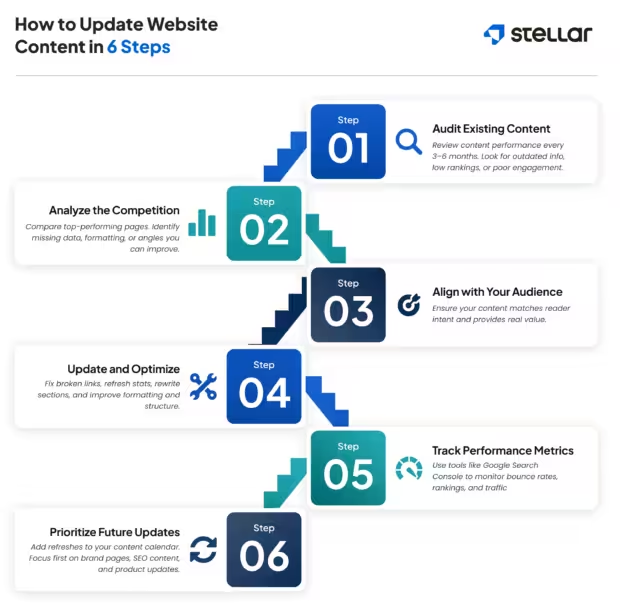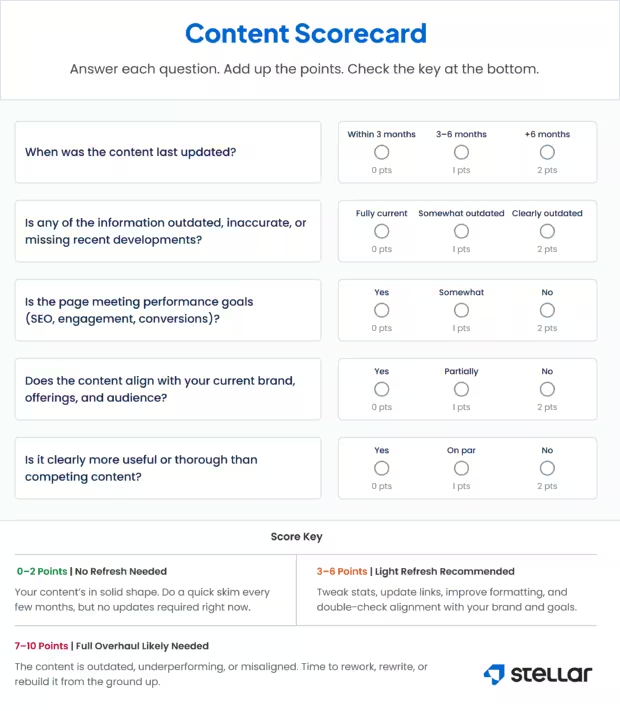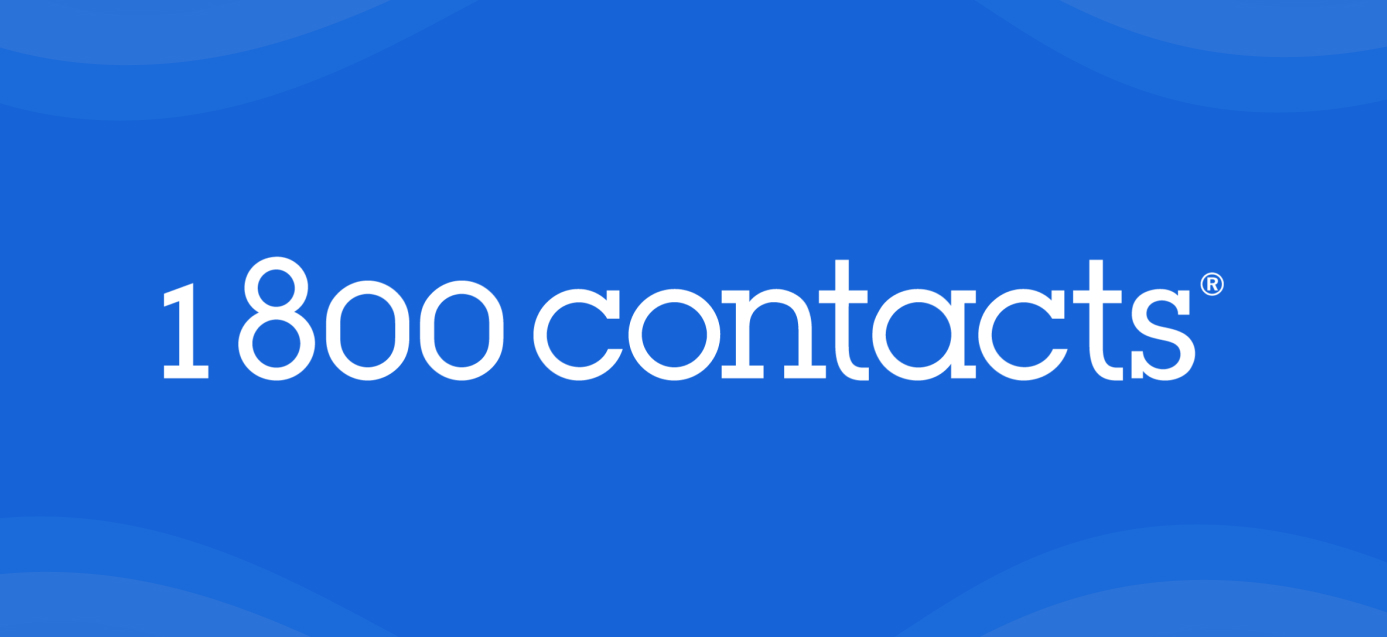
While there is currently no industry standard, updating or refreshing website content every 3-6 months is an excellent best practice. This general guideline helps ensure accuracy, recency, and helpfulness. Ideally, content updates will be tied to performance, meaning pages should be constantly updated based on how they are performing.
The most important things are to:
- Be in the habit of periodically reviewing and updating your published content
- Closely monitor performance
- Identify any opportunities to update, refresh, rewrite, or improve it based on performance
The ideal interval or schedule will depend on your:
- Industry and the related topics you cover
- Goals, objectives, and KPIs
- Performance against your target metrics
What are content updates?
Content updates occur when you add, change or replace information online. Updating content is also known as refreshing, revamping or rewriting content. Simply put, updating your content means keeping your website and its pages up to date and accurate. Content updates can refer to updating individual pages or more general site-wide changes. These updates can be to written content or other types of content like images, infographics, videos and more.
Terms such as cosmetic refresh and content update are used interchangeably. While both terms technically involve website changes, there are some key differences:
- Content updates involve changing informational content on individual pages, such as rewriting a blog post or editing a listicle.
- Cosmetic refreshes happen when you change the look and feel of your website, like updating the company logo or rebranding your identity.
Examples of content updates include:
- Replacing outdated statistics with newer ones
- Removing or changing obsolete facts
- Fixing or replacing broken links
- Rewriting blogs, articles, listicles or other content to better match your brand’s identity or satisfy your audience
- Revising meta descriptions
- Changing headers
- Updating titles
- Replacing photos or changing image captions
- Implementing current data, quotations or testimonials
- Updating outdated references to pop culture, politics or industry trends
- Changing schema markup or alt text
- Adding or changing CTAs to reflect your company’s current sales or marketing goals
- Providing new videos, photos, charts, graphs, tables or other media
- Improving credibility with internal or external links for facts, statistics or info that isn’t common knowledge
- Breaking apart large chunks of text into smaller paragraphs, bullet points or numbered lists
- Removing fluff or filler content that adds length but not value
These changes help keep your content interesting, valuable and relevant to both human readers and search engines.
Aesthetic features capture your audience’s attention initially when they arrive at your website. Up-to-date, engaging content keeps readers on your page — and makes search engines happy.
Does updating content help SEO?
Updating your content supports established SEO best practices and a positive user experience, which are important for visibility.
Some search engines, such as Bing, may deem recency as one of the most important ranking factors. Others, such as Google, may take it into account but find authority more important.
However, let’s say you found one of your pages was outdated, inaccurate, and unhelpful to readers. Let’s say you refreshed the content to improve these issues. As a result, rankings are more likely to improve as well.
For this reason, constantly monitoring performance and updating your content to help improve performance aligns with search engines’ goals of serving up the most accurate, helpful, and easy-to-use content.
In general:
- Content that is up to date, accurate, and ever improving has a better chance of providing value to readers compared to outdated or factually inaccurate content.
- When content is valuable to the audience it was created for, it has a better chance of being visible in search engines.
That said, there are of course many factors that can impact website ranking.
For example, Google prioritizes websites that clearly demonstrate E-E-A-T:
- Experience: A publisher’s personal or professional experience with the topic
- Expertise: In-depth, well-researched information, not surface-level content
- Authority: An author or source that is credible and reputable
- Trustworthiness: Content that is accurate, consistent and unbiased
Outdated, inaccurate or incomplete content damages the four factors highlighted in E-E-A-T, which is bad news for your page’s ranking. In turn, Google and other search engines are unlikely to show your target audience unhelpful content.
The bottom line? Content should be valuable, up-to-date and accurate.
Will you see immediate improvements in rankings after updating a page?
Maybe.
Results usually take time. What you can do to help better position your updated content for results is try these SEO-friendly best practices:
- Create a Last Updated date for each page. This date shows your readers (human ones and search engines) that your content is fresh.
- Submit updated pages to the Google Search Console. Don’t wait for Google to find you — let this popular search engine know that you’re ready now so it can recrawl your pages.
You can also share updated pages on social media or in email blasts to your readers.
Content Updates and SEM
Periodically updating content is just as important for paid search campaigns.
This is because:
- Every keyword your brand bids on is tied to a specific landing page.
- Google’s landing page Quality Score is one assessment of how well that page aligns with the target audience’s expectations.
Strategic improvements and updates to a landing page can help improve Quality Scores. They can help increase conversions, get more out of SEM budgets, and deliver better ROI for paid campaigns.
Quality Scores can help you prioritize new content.
For example, if a particular page’s score still isn’t improving after specific updates, you could first consider assigning a different existing page that might better align with the audience intent. However, if the score still doesn’t improve, you may consider creating a brand new landing page altogether.
Benefits of regularly updating content
Consistently updating content and creating a regular refresh schedule is a wise investment in your overall digital marketing strategy. Content updates can provide numerous benefits to your audience and, in turn, your business.

1. Increased value to audiences
Every update will ideally add value and improve the UX for your target audience (and potential customers).
Reviewing performance data and understanding exactly what your audience expects helps guide strategic updates. These help you get closer and closer to providing the ideal page and, as a result, encourage visibility, engagement and conversions.
2. SEO improvements
Search engines want accurate info because readers want accurate info. They are more likely to crawl, index and rank well-formatted, up-to-date content.
Google strives to make the world’s highest-quality information accessible and useful for as many people as possible. By tweaking posts regularly, you can help contribute to this goal.
3. Improved brand credibility
You can’t be an industry expert if you’re recycling last decade’s trends. Embody the framework of E-E-A-T with current, cutting-edge content that shows you’re an authority in your niche.
Discussing current trends helps showcase expertise and experience. You aren’t just tossing words on a page and hoping readers enjoy them. Instead:
- You’re an expert because you’ve lived what your site discusses.
- You have real value to contribute to the audiences who are looking for the information and solutions you provide.
4. Increased engagement
Readers value expertise. If they’ve made it to your website, they want more info than what the snippets from a quick Google search provide.
Delight your audience (and keep them on your page longer!) with well-researched articles or in-depth blog posts about industry essentials.
5. Strengthened trust
Accurate content is trustworthy content. Google appreciates this, and so do your readers.
After all, if readers can’t trust you, why should they waste time browsing your website?
How to update content
Publishing content should never be the final step in the content creation process. Instead, look at content creation as a cycle which content updates are a crucial part of.
Because of a very common “set it and forget it” mentality to publishing content, many focus exclusively on generating new content versus a combination of strategic refreshes complemented by select new content. Aim to improve what’s already there before adding on more.

Best practices for updating content:
- Perform regular content audits
- Review performance metrics
- Put yourself in your readers’ shoes
- Assess the competition
- Prioritize updates in your content calendar
1. Perform regular content audits
Experts typically recommend updating your content at least twice a year. Check your posts and media at least every 3 to 6 months. Make sure statistics are accurate and facts are relevant.
2. Review performance metrics
During your audits, you should also check whether published pages:
- Rank well in SERPs
- Show up in Featured Snippets or AI overviews
- Have low bounce rates or poor engagement
- Receive new and returning visitors regularly
These results can help you determine how to proceed when you tweak blog posts or articles.
Google Analytics and Search Console can help you track the following:
- Keyword position
- Bounce rate
- Visitors
- Time on site
Consistently reviewing these metrics and others can help you:
- Determine which pages need the most attention
- Create a content update priority list to make the process as efficient as possible
3. Put yourself in your readers’ shoes
Just like when you create content, keep your audience in mind when you revamp your content. Content that considers what the audience seeks and prefers has a better chance of reaching that audience.
Be sure to assess whether or not your content aligns with the target audience’s intent by asking questions like:
- What is your target audience looking for?
- What do they expect to find?
- How do they prefer to see it formatted?
- Does your content solve problems or leave readers hanging?
- What can you do to cover topics in more detail and answer questions your audience may have?
The answers to these questions help you understand exactly what to provide and how to provide it. Along with any performance data, they can help guide which content updates and improvements you make.
Similarly, ideal formatting makes it easier for readers to digest the information your content provides. In addition to ensuring factual accuracy, the right text size and color, along with correct spacing and a user-friendly layout, can make your website more attractive.
Formatting updates that help improve UX include:
- Digestible sections with optimized headings that break up content into more snackable pieces
- Easy to skim numbered or bulleted lists that help break up inaccessible walls of text
- Bold or italicized text that help highlight key information
- Media like infographics and videos that give readers more options on how to engage with the information
- Key information delivered immediately and high up on the page so readers can find it quickly
Pretend you know nothing about your niche but are in a hurry to learn about it.
4. Assess the competition
Find out, and aim to incorporate these elements into your refreshes. You have an opportunity to better position yourself as an industry expert and provide more value to target audiences with unique, up-to-date information.
Here is some information to check for:
- Facts, figures and other essential data
- Company information (how it’s reflected in the schema and on the page)
- Clearly defined, effective CTAs
- Product and service information
- Helpful information such as recommendations, tips, and step-by-step tutorials
- FAQs
5. Prioritize updates in your content calendar
Refreshes are just as important — sometimes even more important — than new content creation. Create a designated time and plan for content updates.
Start here:
- Company information. Your readers go to your About Us, Our Team or Contact Us pages to find current information about your business. Update these pages immediately when something changes.
- Brand accuracy. Notify readers ASAP if anything changes with your brand, products or services.
- Key SEO pages. Revamp these pages if traffic is too low, clicks aren’t converting or statistics are outdated.
The importance of updating content
Content isn’t a create-it-and-forget-it feature on your website. Regularly updating content is an essential part of the content creation cycle and key to visibility. Content updates help support SEO best practices and better satisfy target audiences.
Remember: A content update means refreshing actual page information, not just tweaking your company’s logo or website colors. There’s no industry standard for content updates, but aim to refresh your content at least once every 3 to 6 months. Perform regular content audits and continuously assess performance to help prioritize refreshes.

